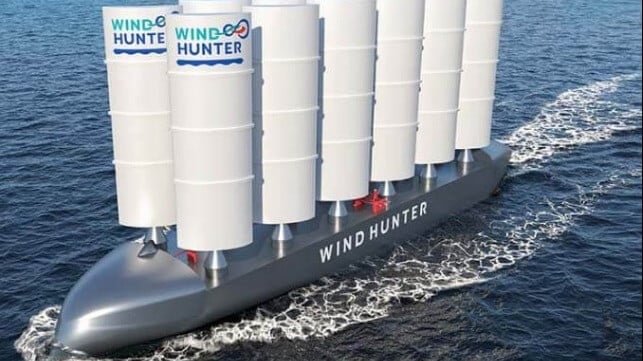MOL Moves Forward with Wind Hunter Sail-Powered Ship that Produces Hydrogen

Mitsui O.S.K. Lines working with its partners at Kyushu University and Taiyo Sangyo Co. is moving forward with the next phase of their Wind Hunter Project, a concept to create a zero-emission ship using wind power and producing hydrogen from seawater. The project will move forward on the development of technology to purify water for the production of hydrogen with the support of a Japanese subsidy program.
The principle behind the Wind Hunter is that the vessel would use sails for a portion of its propulsion and also produce hydrogen that would be stored in tanks on board. When the wind is weak, the ship would use that hydrogen as a fuel cell delivering electricity and in turn powering electric propellers that drive the ship forward. MOL revealed the concept in 2020 and since then the partners have successfully tested some of the concepts.
Hydrogen production they explain requires a higher level of water purity, even more than drinking water. During the Wind Hunter hydrogen production process, seawater would be first purified by passing it through a filter to remove impurities such as organic matter (carbon content, microplastics, etc.), inorganic matter (iron, magnesium, sodium), and sludge, but they note that the filters currently in common use require frequent replacement. Those filters MOL says would increase the workload of crewmembers and imposes a significant cost burden on the vessel.
In the next phase of the Wind Hunter project, the partners will work together to develop long-lasting, durable, and high-performance filters. These next-generation filters will be able to remove even bacteria, which the companies note will require even more advanced technology in the future, and to manufacture a pure water production system.
The development of more efficient onboard technology to produce pure water from seawater in the Wind Hunter project will mark a major step MOL notes toward the realization of large zero-emission ships. The technology will not only create pure water production technology for the Wind Hunter project, but they believe will also apply the developed technology to supply pure water to hydrogen production plants and other applications.
The project calls for developing a pure water production system that will be designed not only for seawater but also for fresh water. They plan to conduct a demonstration test in Lake Biwa, the largest lake in Japan.
MOL reports it will assess the effects of differences in water quality and establish a versatile pure water production technology by comparing seawater with fresh water from Lake Biwa.
After having completed tests on a small ship in Nagasaki in 2021, MOL said the project aims to create a larger scale, about 195-foot long vessel, by 2024 as the second stage of testing. The Wind Hunter project plan calls for the development and construction of a much larger-scale zero-emission vessel by 2030.
